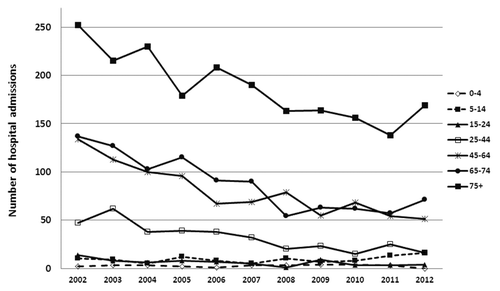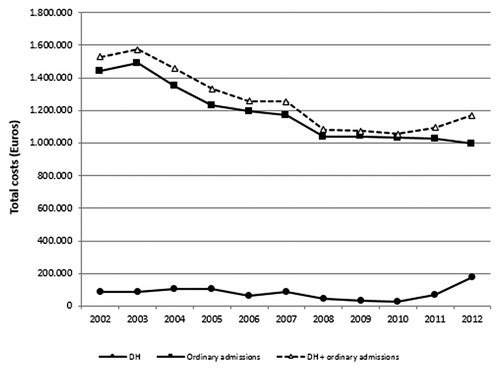Abstract
Herpes zoster (HZ) is a disease caused by the reactivation of the latent α-herpes virus varicella zoster virus (VZV), for which, in Italy, a specific surveillance system does not exist, but around 200 000 cases are estimated each year. In older patients, who are at increased risk of developing HZ, symptoms are more severe and the chances to develop postherpetic neuralgia (PHN), the most severe complication, are substantially higher. A vaccine against HZ with demonstrated efficacy and an acceptable safety profile is now available and is recommended in Europe for adults >50 years.
In anticipation of the possible introduction of an immunization programme for the elderly in Tuscany, the burden of disease caused by HZ and its complications was assessed through a retrospective analysis of the hospital discharge records between 2002 and 2012, using the ICD-9-CM 053 code.
In the period 2002–2012, 4475 hospital admissions were registered with annual means of 368 hospitalizations and 39 day-hospital admissions. Most of the hospitalizations (68%) involved subjects > 65 years; the mean length of stay was 9.5 days. Slightly more than half (51.2%) of total hospital admissions were complicated cases. The most frequent were neurological complications (24.2% of total admissions), followed by ophthalmic complications (16.5%). Cases with neurological complications were those with the higher average length of stay and higher average costs for case.
This study confirmed the epidemiological impact of HZ and its complications and the positive impact on morbidity that the introduction of the HZ vaccination could have in older age groups.
Introduction
Herpes Zoster (HZ) is a disease caused by the reactivation of the varicella-zoster virus (VZV). All patients who had varicella in the past are susceptible. Although the onset of HZ is the result of a multifactorial process, an important role in the reactivation of the virus is attributed to deficiency of the T-cellular-mediated response, especially the VZV-specific T-cellular-mediated immunity, caused by immunosenescence and immunosuppressive conditions.Citation1,Citation2 After having infected the sensory nerves in mucocutaneous sites during primary infection, VZV becomes latent in the sensory ganglia (usually T3-L3),Citation3 where a new replicative phase can occur, years or decades later, especially in immunocompromised hosts, as a result of certain diseases (e.g., HIV infection, Hodgkin disease, non-Hodgkin lymphomas, leukemia, bone marrow and other organ transplants, systemic lupus erythematosus), drugs, psychological stress, malnutrition or as a consequence of the natural decline of the immune system with age.Citation4 The infection of sensory nerves in the epithelium and the typical vesicular rash then ensue. The patient experiences sensory loss, pain and, if motor nerve roots are also involved, weakness.
The lifetime risk of developing an episode of zoster is estimated to be equal to 10–30% and it is strictly age-related. As a matter of fact, incidence increases sharply with age, and it has been calculated that about 50% of subjects aged 80 y or greater develop at least one episode of HZ.Citation5,Citation6
Prodromal symptoms usually last for one to five days before the appearance of skin lesions, and include itching, numbness, tingling, malaise, fever, chills, myalgia, headache, dyspepsia and/or severe localized pain. The maculopapular rash appearing afterwards evolves into clusters of vesicles that spread into a linear pattern that does not cross the midline of the body. Within 3–5 d lesions progress into pustules, ulcerations and crusting and heal spontaneously within one month.Citation7
Zoster’s clinical signs are usually localized in the sensory region of the affected ganglia, but the manifestations can be systemic in immunocompromised patients, and sometimes atypical presentations, forms with necrosis and involvement of internal organs (lungs, liver, and brain), may arise.Citation8 Typically, the crust formation occurs in 7–10 d. Along with the rash, most patients experience a dermatomal pain syndrome caused by acute neuritis, described as a burning, tingling, itching, or stabbing, mild to severe pain. In some cases mild forms without rash (zoster sine herpete), can occur.Citation9
Among all complications, which occur in 20% of cases,Citation10,Citation11 especially fearful is the postherpetic neuralgia (PHN), a painful chronic condition that resists to different treatments and affects 10–20% (but according to some authors up to one third) of patients, especially elderly, with an acute episode of zoster. As a matter of fact, 60% to 70% of people aged >60 y with shingles experience PHN.Citation10,Citation11 Patients with PHN may endure constant or intermittent pain, allodynia, chronic fatigue, sleep disorders, depression, anorexia, weight loss and social isolation.Citation4,Citation9 Ultimately, the patient’s functional status may be impaired due to the greater difficulty to perform the activities of daily living.Citation12
HZ can also affect cranial nerves. The ophthalmic branch of the trigeminal nerve is affected in HZ ophthalmicus, for which blisters on the tip of the nose represent a common indicator (Hutchinson sign) and a predictor for possible serious complications, such as ocular inflammation, eyelid dermatitis, keratoconjunctivitis, iridocyclitis, corneal denervation with impaired vision. Although in rare cases, when the ophthalmic division of the trigeminal nerve is affected (trigeminal postherpetic neuralgia), leptomeningeal involvement can also cause meningitis. Stroke secondary to granulomatous arteritis of the internal carotid artery is another possible complication in ophthalmic HZ.Citation13
Ramsay Hunt syndrome (HZ oticus), is an infection of the facial nerve, identified by the occurrence of severe ear pain, facial muscle weakness and a rash often involving the pinna or tragus of the external ear or the tympanic membrane. It can provoke vertigo, hearing, and facial paresis in cranial neuritis.Citation14
According to Schmader et al., 2001, the prevalence of pain >1 mo after onset of rash is 3–4% in the age group of 30–49 y, sharply increases with age and reaches 34% in patients aged >80 y.Citation4
The incidence in Europe, as a recent systematic literature review revealed, varies by country from 2.0 to 4.6/1000 person-years, with no clear geographic trend.Citation15 Age-specific HZ incidence rates are estimated to be around 1/1000 in children <10 y, around 2/1000 in adults aged <40 y, around 1–4/1000 in adults aged 40–50 y, around 7–8/1000 in >50 y individuals and up to 10/1000 after 80-y-of-age.
In Italy HZ is included in class V in the notification system for infectious diseases, and like many other diseases in this class, it is improperly considered not subject to mandatory notification. However, around 200 000 cases are estimated each year.Citation2 In a recent retrospective population-based study, epidemiological data were estimated in adult men and women aged ≥50 y, from a large primary-care database and national hospital-discharge records. An incidence of 6.31 per 1000 person-years was reported for individuals >50-y-old. The incidence was 4.31 per 1000 person-years for the adult population as a whole.Citation16
A varicella–zoster vaccine for the prevention of HZ with a high antigenic content (>19 400 Plaque-forming units of VZV), has been made available since 2006.Citation17 It is a live attenuated vaccine (Oka/Merck strain) that has proven to be safe and well tolerated: apart from minor discomfort at the injection site, no clinically relevant side effects have been reported.Citation18 Only one dose is necessary and boosters are not required. The European Medicines Agency authorizes its use in Europe for adults aged 50 y and older to prevent this disease.
With the aim to evaluate the burden of HZ and to estimate the impact that the introduction of an immunization programme for the elderly would have in the Tuscany Region (Central Italy), we conducted a retrospective analysis of all hospital admissions due to the disease and its complications occurred in the region between 2002 and 2012. The search of the regional hospital discharge records (Schede di Dimissione Ospedaliera, SDO) was performed on the basis of The International Classification of Diseases, Ninth Revision, Clinical Modification (ICD-9-CM) 053 code, which identifies herpes zoster and its complications.
Results
Between 2002 and 2012, 4475 hospital admissions for herpes zoster-related diseases were registered in Tuscany: 4078 ordinary (368 yearly average of ordinary hospital admissions) and 427-d-hospital (DH) admissions (on average 39 DH admissions were reported each year). The hospitalization rate for HZ decreased from 17/100 000 in 2002 to 8/100 000 in 2011 (; ).
Figure 1. Number of hospitalizations (ordinary + DH admissions) for HZ-related diseases and hospitalization rate × 100 000, Tuscany, 2002–2012.
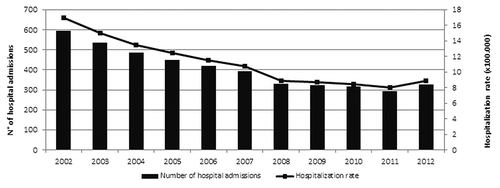
Table 1. Number of hospitalizations (ordinary+ DH admissions) for HZ-related diseases and hospitalization rates × 100 000, Tuscany, 2002–2012
A decrease of the yearly average hospitalization rate, from 17/100 000 in 2002 to 8.9/100 000 in 2012 and of the average rate of ordinary admissions, from 15.3/100 000 in 2002 to 7.8/100 000 in 2012, was observed (; ) and reflected the decrease of the hospital ordinary admissions rate from all causes in Tuscany during the same period (which decreased from 131.78/1000 in 2002 to 103.6/1000 in 2012). The number of DH admissions declined from 1.7/100 000 in 2002 to 0.3/100 000 in 2009, to increase again thereafter: the DH admission rate was equal to 1.1/100 000 in 2012 (; ).
A decreasing trend was observed for both genders. The absolute number of cases was higher in females (54% against 46%). For males, the hospital admissions were in total 2048 between 2002 and 2012, the standardized hospitalization rate for males was 18.89/100 000 in 2002 and 9.65/100 000 in 2012, while for females there were 2427 hospital admissions and the hospitalization rate was 15.18/100 000 in 2002 and 8.25/100 000 in 2012.
Stratifying into age groups, the number of hospital admissions increased with age (; ): as a matter of fact, 2064 hospitalizations (46% of the total cases) were recorded in patients older than 75 y, 970 (22%) in patients aged 65–74-y-old, 886 (20%) in patients aged 45–64, 355 (8%) in patients aged 25–44, 68 (1.5%) in patients aged 15–24-y-old, 103 (2.3%) in the 5–14 age group, and only 28 (0.6%) in children aged 0–4 y.
Table 2. Hospitalizations for HZ-related diseases stratified by age groups, Tuscany, 2002–2012
Filtering the data by ICD9-CM053 code, 48.8% of admissions (n = 2,183) were HZ cases without mention of complication, whereas the remaining 51.2% were complicated cases (). The most frequent were neurological complications, which represented the 24.2% of the total hospital admissions (n = 1082). In particular, HZ with other complications of the nervous system accounted for 7.8% of total cases, postherpetic polyneuropathy for 4.3%, HZ with unspecified complications of the nervous system for 4.1%, HZ with meningitis caused 2.9% of cases, Ramsay Hunt syndrome was reported in 2.4% of cases, trigeminal postherpetic neuralgia in 2.4% of cases, HZ with myelitis in 0.3% of cases.
Figure 3. Hospital admissions for HZ-related diseases stratified by ICD9-CM codes, Tuscany, 2002–2012.
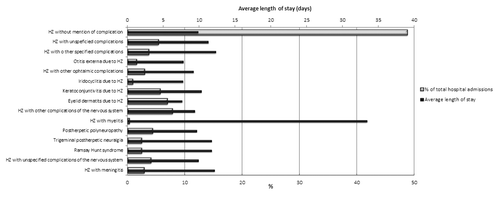
The second most common complications were ophthalmic complications, which occurred in 16.5% of the cases (n = 738) (eyelid dermatitis and keratoconjunctivitis due to HZ were the second and third most common complications on the total cases, accounting for 7.0% and 5.7% of cases, respectively).
The remaining 10% included the following codes: 05371 (Otitis externa due to HZ), 05379 (HZ with other specified complications) and 0538 (HZ with unspecified complications). A constant decreasing trend was especially registered for cases without complications (from 8.2/100 000 cases in 2002 to 4.4/100 000 cases in 2012) or with ocular complications (from 3.6/100 000 in 2002 to 1.0/100 000 in 2012). The cases with neurological complications or meningitis remained more stable in the period under scrutiny. These accounted for 3.9/100 000 cases in 2002 and for 2.8/100 000 cases in 2012.
Cases with neurological complications were those with the higher average length of stay: the longest average length of stay was reported for cases of HZ myelitis (33.4 d), followed by cases of HZ with unspecified complications and HZ with meningitis (both with an average length of stay >12 d), and cases with Ramsay Hunt syndrome and trigeminal postherpetic neuralgia, both at 11.8 d ().
Cases with otitis externa due to HZ, iridocyclitis due to HZ or eyelid dermatitis due to HZ were those with the shortest average length of stay (<8 d).
In summary, if we consider the average length of stay for each complication we can see how HZ with myelitis, which caused only 0.3% of the total cases, produced admissions with an average length of 33 d, more than 3 times the average of all the patients’ stays (9.5 d). On the other hand, all the other complications had an average length of stays very close to the mean value, in fact they were all included in the range 7.6–12.3 d ().
The 4,475 admissions in the period 2002–2012 accounted for 42 800 d of hospital stay (annual average length of stay = 3.9 d). The length of hospital stay constantly decreased until 2011 and in each age group. Considering the age-stratified length of hospitalizations, the 70% of days spent in hospital were reported for patients older than 65, the 90% in individuals older than 45. The average length of stay for HZ was 9.5 d. It was 10 d for ordinary hospital admissions and 5 d for DH admissions, and it remained nearly unmodified in the considered period, but it was strictly related to patients’ age. In fact, it increased from an average length of 9.6 d in the youngest age groups (0–65 y) to 10.2 d in patients older than 65 y ().
Figure 4. Average length of stay of hospitalized cases (DH excluded) for HZ-related diseases by age groups, Tuscany, 2002–2012.
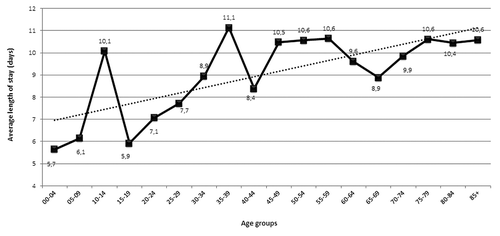
In the 11 y considered, the global cost of hospital admissions for HZ was 13 876 979 euros (880 594 euros for DH admissions and 12 996 385 euros for ordinary admissions), with annual average costs of 1 261 544 euros and 3101 euros, globally, and per hospitalized case, respectively. Total costs for ordinary admissions decreased, especially until 2008 (). Costs for DH admissions have been increasing since 2010.
Cases of HZ without mention of complication (ICD-9-CM code 0539) were those that determined the higher costs (6 944 526 euros), followed by HZ with other complications of the nervous system (ICD-9-CM code 05319) (1 125 769.6 euros), and by postherpetic polyneuropathy (ICD-9-CM code 05313) (755 713 euros). Cases of HZ myelitis (ICD-9-CM code 05314) were those with the highest average cost per case (7115.85 euros), followed by postherpetic polyneuropathy (ICD-9-CM code 05313) (3797.55 euros) and by HZ with meningitis (ICD-9-CM code 0530) (3739.46 euros).
Stratifying by age groups, the average cost per hospitalization increased with age. The number of cases decreased more than the total costs, so that fewer patients contributed to higher costs. Among DH, the average cost of hospitalization for a subject >75 increased from 1572 € in 2002 to 4836 € in 2012 (+208%); for ordinary admissions the average cost was 2653 € in 2002, and 3441.5 € in 2012 (+29.7%). An increase was observed also for the average cost in the age group 65–74 y, both for DH, from 1675 € in 2002 to 4884 € in 2012 (+191%), and for ordinary admissions, from 2667 € in 2002 to 3512 € in 2012 (+31.7%).
Also in the age group 15–64 y the total costs for ordinary admissions in 2012 (227 827 €) were half of those sustained in 2002 (432 607 €), while costs for DH in the same 2 y decreased from 45 387 € to 35 472€. As the number of admissions decreased from 34 to 7 for DH, and from 161 to 64 for ordinary admissions, the average cost increased in both cases: for DH from 1335 € in 2002 to 5067.4 € in 2012 (+279%), and for ordinary admissions from 2687 € in 2002 to 3559.8 € in 2012 (+32.5%).
Discussion
The purpose of the present study was to evaluate the impact of HZ in Tuscany in terms of hospitalizations. The results were consistent with results previously published on hospitalizations caused by HZ in Italy in terms of number of hospitalizations, length of stay, and costs.Citation6 In fact, our findings confirmed the epidemiological impact of HZ and its complications, especially upon the older age groups (individuals >65 y), that have the highest burden in terms of number of cases, length of stay and costs sustained. Between 2002 and 2012, a gradual decrease of the hospitalization rate and of the total days spent in hospital because of HZ-related diseases was observed, while the average length of stay associated for hospitalized cases remained stable. The analysis of the ICD9-CM codes showed that about half of the hospital admissions were HZ cases without complications. The most frequent complications were neurological (24.2% of hospital admissions), followed by ophthalmic complications, which represented the 16.5% of cases.
Trigeminal postherpetic neuralgia, which represented 2.4% total HZ cases, and 10% of HZ with neurological complications, caused an average length of stay of 11.8 d and involved mostly older people: as a matter of fact, 50% of the cases were registered in people older than 74 y, 28.3% in people aged 65–74 y, 18.5% in people aged 45–64 y, and only 3.2% in people younger than 45 y.
The total costs of hospitalization decreased, in conjunction with the reduction of the hospitalization rate (ordinary admissions). Nevertheless, in patients older than 65, both the costs of day-hospital admissions and the costs for each ordinary admission rose noticeably. The decrease of the hospitalization rate for ordinary admissions and the increase of the costs associated with each hospitalized case for subjects in the older age groups, together with the increase, since 2009, in the rate of DH admissions, reflects a shift to a more intensive treatment regimen and, consequently, a more appropriate hospital utilization in the region. Presently, hospitalized patients are those with more severe manifestations of the disease, mostly individuals in the older age groups. In fact, a decreasing trend in the number of cases of HZ without mention of complication and of HZ with ocular complications was observed, while cases of HZ with neurological complications remained quite stable in the period examined. This finding is particularly noteworthy, as the introduction of an immunization programme for the elderly would specifically benefit these complicated cases. As a matter of fact, while from the results of the “Zest Study”, a double-blind clinical trial evaluating the efficacy and safety of the varicella-zoster vaccine in subjects 50–59-y-of-age, it emerged that the vaccine efficacy (VE) for the incidence of HZ in individuals aged 50–59 was 69.8%,Citation19 results from the “Shingles Prevention Study,” a double-blind clinical trial evaluating the vaccine efficacy in subjects 60-y-of-age or older, showed that the VE for the incidence of HZ in individuals ≥60 y was 51.3% (VE was 63.9% in subjects aged 60–69-y-old, but only 37,6% in subjects ≥70 y), and that the protection conferred against the most severe complications is higher in the older age groups.Citation20 In fact, the zoster vaccine reduces the incidence of postherpetic neuralgia by 66.5%, and VE for the incidence of PHN was higher, 66.8%, in subjects ≥70-y-of-age, precisely those most often affected by this complication (they accounted for 71% of the cases of PHN in the Shingles Prevention Study). Furthermore, it was observed that VE for the incidence of PHN increases to 73% when only cases with HZ Severity of Illness Scores > 600 (equivalent to > 60 d of the “worst pain imaginable”) are taken into account, and to 82% when only cases with HZ Severity of Illness Scores > 800 (equivalent to >80 d of the “worst pain imaginable”) are considered.Citation20
Recently, in the systematic review by Kawai et al.Citation21 on 15 cost-effectiveness studies performed in the USA, Canada and Europe (Belgium, France, Germany, the Netherlands, Switzerland, and the UK), it was pointed out the likely cost-effectiveness of the HZ vaccine was pointed out. A cost ranging from 10.000$ to more than 100.000$ per QALY gained was calculated, the differences being mainly due to the differing assumptions on the duration of vaccine protection, on the loss in quality of life associated with HZ and PHN and on the risk of PHN in adults ≥70-y-of-age.
Currently, vaccination is recommended in Australia, Canada, Korea, Israel, and USA in individuals >60-y-old. In Europe, vaccination is recommended in Austria and Germany for individuals older than 50; in the UK it was recommended and funded through public funding to a cohort of individuals aged 70 with the catch-up of 71–79-y-old subjects. In France, it is recommended to 65–74-y-old individuals with a catch up of individuals aged 75–79, in Greece it is recommended for people aged 60 or greater but considered necessary only for people at higher risk. In the Netherlands, it is advised in those ≥65-y-old. In Sweden the vaccination is completely reimbursed for individuals older than 50.Citation22
In Italy, as in other European countries, the serum prevalence of VZV is 95% in the adults,Citation23 and the population aged 60 or more is growing faster than younger adults and children. The burden of disease is therefore expected to rise. The benefits that the introduction of an immunization programme aimed at the elderly could have on the morbidity caused by the disease in our Region and on the financial burden sustained by the National Health System are substantial. Not only would the most serious, complicated cases be strongly reduced. The impact of the vaccination would also cause a significant reduction in the number of uncomplicated cases, which, as it was highlighted in the present study, represent nonetheless a high proportion of patients admitted to hospital and greatly contribute to the burden of illness and to the costs of treatment.
In order to optimize the cost-effectiveness of this measure, important key-factors, such as the target population, the duration of vaccine protection, and economic parameters, like the average costs of HZ cases for primary care visits and medications or the cost of vaccination, need to be further assessed in relation to the local context.Citation24-Citation28
Materials and Methods
For the purpose of the present study, data about the hospital discharge records (SDO) of patients admitted to hospitals in Tuscany Region between 2002 and 2012 were collected from the regional database. In detail, hospital admissions due to herpes zoster and its complications were searched by means of the ICD9-CM 053 code. The descriptive analysis was conducted on the records of patients admitted for the following conditions: zoster (ICD-9-CM 053), herpes zoster with meningitis (ICD-9-CM 0530), herpes zoster with unspecified complications of the nervous system (ICD-9-CM 05310), Ramsay Hunt syndrome (ICD-9-CM 05311), trigeminal postherpetic neuralgia (ICD-9-CM 05312), postherpetic polyneuropathy (ICD-9-CM 05313), herpes zoster with myelitis (ICD-9-CM 05314), herpes zoster with other complications of the nervous system (ICD-9-CM 05319), eyelid dermatitis due to herpes zoster (ICD-9-CM 05320), keratoconjunctivitis due to herpes zoster (ICD-9-CM 05321), herpes zoster iridocyclitis (ICD-9-CM 05322), herpes zoster with other ophthalmic complications (ICD-9-CM 05329), otitis externa due to herpes zoster (ICD-9-CM 05371), herpes zoster with other specified complications (ICD-9-CM 05379), herpes zoster with unspecified complications (ICD-9-CM 0538), herpes zoster without mention of complication (ICD-9-CM 0539).
Due to privacy regulations, data were obtained grouped by year of admission, region and Local Health Unit of residence (or State in case of non-Italian citizens), age group (each age group covering 5 y), gender, citizenship, and type of admission (Day-hospital or ordinary admission). The retrospective analysis was conducted using Microsoft Excel 2003.
| Abbreviations: | ||
| DH | = | Day-hospital |
| HIV | = | Human immunodeficiency virus |
| HZ | = | Herpes zoster |
| ICD-9-CM | = | International Classification of Diseases, Ninth Revision, Clinical Modification |
| PHN | = | Postherpetic neuralgia |
| QALY | = | Quality-adjusted life-year |
| VE | = | Vaccine efficacy |
| VZV | = | Varicella zoster virus |
Disclosure of Potential Conflicts of Interest
No potential conflicts of interest were disclosed.
Financial Support
The present study was part of the Project “Assessment of clinical burden and socio-economic impact of Herpes Zoster and evaluation of vaccination strategies among adult population in Italy,” and it was financed by the Centre for Diseases Control (CCM) of the Italian Ministry of Health.
References
- Gabutti G, Serenelli C, Sarno O, Marconi S, Corazza M, Virgili A. Epidemiologic features of patients affected by herpes zoster: database analysis of the Ferrara University Dermatology Unit, Italy. Med Mal Infect 2010; 40:268 - 72; http://dx.doi.org/10.1016/j.medmal.2009.09.005; PMID: 19836913
- Gershon AA, Gershon MD, Breuer J, Levin MJ, Oaklander AL, Griffiths PD. Advances in the understanding of the pathogenesis and epidemiology of herpes zoster. J Clin Virol 2010; 48:Suppl 1 S2 - 7; http://dx.doi.org/10.1016/S1386-6532(10)70002-0; PMID: 20510263
- Cherubini A, Gasperini B. Prevenzione delle infezioni da Herpes Zoster nella popolazione anziana e gestione della nevralgia post-erpetica. [Prevention of Herpes Zoster infections in the elderly and management of post-herpetic neuralgia] G Gerontol 2008; 56:146 - 53
- Yoshikawa TT, Schmader K. Herpes zoster in older adults. Clin Infect Dis 2001; 32:1481 - 6; http://dx.doi.org/10.1086/320169; PMID: 11317250
- Gauthier A, Breuer J, Carrington D, Martin M, Rémy V. Epidemiology and cost of herpes zoster and post-herpetic neuralgia in the United Kingdom. Epidemiol Infect 2009; 137:38 - 47; http://dx.doi.org/10.1017/S0950268808000678; PMID: 18466661
- Gabutti G, Serenelli C, Cavallaro A, Ragni P. Herpes zoster associated hospital admissions in Italy: review of the hospital discharge forms. Int J Environ Res Public Health 2009; 6:2344 - 53; http://dx.doi.org/10.3390/ijerph6092344; PMID: 19826547
- Gagliardi AM, Gomes Silva BN, Torloni MR, Soares BG. Vaccines for preventing herpes zoster in older adults. Cochrane Database Syst Rev 2012; 10:CD008858; PMID: 23076951
- Brisson M, Edmunds WJ, Law B, Gay NJ, Walld R, Brownell M, Roos L, De Serres G. Epidemiology of varicella zoster virus infection in Canada and the United Kingdom. Epidemiol Infect 2001; 127:305 - 14; http://dx.doi.org/10.1017/S0950268801005921; PMID: 11693508
- Schmader K. Herpes Zoster. In: Yoshikawa T, Norman D, eds. Infectious Disease in the Aging - A Clinical Handbook. 2nd Edition: Humana Press, 2009:229-42.
- Bowsher D. Factors influencing the features of postherpetic neuralgia and outcome when treated with tricyclics. Eur J Pain 2003; 7:1 - 7; http://dx.doi.org/10.1016/S1090-3801(02)00060-5; PMID: 12527312
- Jung BF, Johnson RW, Griffin DRJ, Dworkin RH. Risk factors for postherpetic neuralgia in patients with herpes zoster. Neurology 2004; 62:1545 - 51; http://dx.doi.org/10.1212/01.WNL.0000123261.00004.29; PMID: 15136679
- Katz J, Cooper EM, Walther RR, Sweeney EW, Dworkin RH. Acute pain in herpes zoster and its impact on health-related quality of life. Clin Infect Dis 2004; 39:342 - 8; http://dx.doi.org/10.1086/421942; PMID: 15307000
- Langan SM, Minassian C, Smeeth L, Thomas SL. Risk of stroke following herpes zoster: a self-controlled case-series study. Clin Infect Dis 2014; 58:1497 - 503; http://dx.doi.org/10.1093/cid/ciu098; PMID: 24700656
- Wilson DD. Herpes zoster: A rash demanding careful evaluation. Nurse Pract 2014; 39:30 - 6, quiz 36-7; http://dx.doi.org/10.1097/01.NPR.0000445781.37062.16; PMID: 24681697
- Pinchinat S, Cebrián-Cuenca AM, Bricout H, Johnson RW. Similar herpes zoster incidence across Europe: results from a systematic literature review. BMC Infect Dis 2013; 13:170; http://dx.doi.org/10.1186/1471-2334-13-170; PMID: 23574765
- Gialloreti LE, Merito M, Pezzotti P, Naldi L, Gatti A, Beillat M, Serradell L, di Marzo R, Volpi A. Epidemiology and economic burden of herpes zoster and post-herpetic neuralgia in Italy: a retrospective, population-based study. BMC Infect Dis 2010; 10:230; http://dx.doi.org/10.1186/1471-2334-10-230; PMID: 20682044
- Edmunds WJ, Brisson M, Rose JD. The epidemiology of herpes zoster and potential cost-effectiveness of vaccination in England and Wales. Vaccine 2001; 19:3076 - 90; http://dx.doi.org/10.1016/S0264-410X(01)00044-5; PMID: 11312002
- Gould D. Varicella zoster virus: chickenpox and shingles. Nurs Stand 2014; 28:52 - 8, quiz 60; http://dx.doi.org/10.7748/ns2014.04.28.33.52.e8249; PMID: 24734838
- Schmader KE, Levin MJ, Gnann JW Jr., McNeil SA, Vesikari T, Betts RF, Keay S, Stek JE, Bundick ND, Su S-C, et al. Efficacy, safety, and tolerability of herpes zoster vaccine in persons aged 50-59 years. Clin Infect Dis 2012; 54:922 - 8; http://dx.doi.org/10.1093/cid/cir970; PMID: 22291101
- Oxman MN. Vaccination to prevent herpes zoster and postherpetic neuralgia. Hum Vaccin 2007; 3:64 - 8; http://dx.doi.org/10.4161/hv.3.2.3746; PMID: 17299270
- Kawai K, Preaud E, Baron-Papillon F, Largeron N, Acosta CJ. Cost-effectiveness of vaccination against herpes zoster and postherpetic neuralgia: a critical review. Vaccine 2014; 32:1645 - 53; http://dx.doi.org/10.1016/j.vaccine.2014.01.058; PMID: 24534737
- http://www.sigg.it/public/doc/congresso/58/29-11-2013/SALA-500/12.30%20-%2013.00/174-Stefania%20Maggi/Stefania-Maggi.pdf.
- Nardone A, de Ory F, Carton M, Cohen D, van Damme P, Davidkin I, Rota MC, de Melker H, Mossong J, Slacikova M, et al. The comparative sero-epidemiology of varicella zoster virus in 11 countries in the European region. Vaccine 2007; 25:7866 - 72; http://dx.doi.org/10.1016/j.vaccine.2007.07.036; PMID: 17919788
- Ultsch B, Weidemann F, Reinhold T, Siedler A, Krause G, Wichmann O. Health economic evaluation of vaccination strategies for the prevention of herpes zoster and postherpetic neuralgia in Germany. BMC Health Serv Res 2013; 13:359; http://dx.doi.org/10.1186/1472-6963-13-359; PMID: 24070414
- Sanford M, Keating GM. Zoster vaccine (Zostavax): a review of its use in preventing herpes zoster and postherpetic neuralgia in older adults. Drugs Aging 2010; 27:159 - 76; http://dx.doi.org/10.2165/10489140-000000000-00000; PMID: 20104941
- de Boer PT, Pouwels KB, Cox JM, Hak E, Wilschut JC, Postma MJ. Cost-effectiveness of vaccination of the elderly against herpes zoster in The Netherlands. Vaccine 2013; 31:1276 - 83; http://dx.doi.org/10.1016/j.vaccine.2012.12.067; PMID: 23306360
- Kawai K, Preaud E, Baron-Papillon F, Largeron N, Acosta CJ. Cost-effectiveness of vaccination against herpes zoster and postherpetic neuralgia: a critical review. Vaccine 2014; 32:1645 - 53; http://dx.doi.org/10.1016/j.vaccine.2014.01.058; PMID: 24534737
- Szucs TD, Pfeil AM. A systematic review of the cost effectiveness of herpes zoster vaccination. Pharmacoeconomics 2013; 31:125 - 36; http://dx.doi.org/10.1007/s40273-012-0020-7; PMID: 23335045

